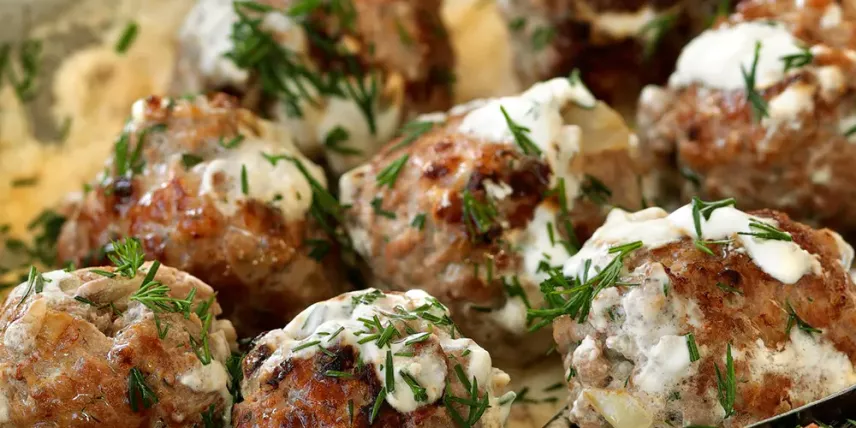Swedish Cuisine

Sweden and Its National Cuisine
Sweden is a unique country that deserves attention in many ways, and one of the prides of Sweden, of course, is the food. Swedish cuisine is highly dependent on which part of the country you are in. For example, in the north of Sweden they eat venison, but in the south they eat more vegetables. Swedish dishes can be described as simple with contrasting flavors. Other countries have also influenced the recipes of Swedish cuisine - for example, French cuisine, which strongly influenced Swedish cuisine in the 17th and 18th centuries.
Typical Swedish Dishes
Cranberry Jam
Cranberry Jam - Like other sauces and condiments, lingonberry jam is a common sight on the buffet. Jam can be combined with almost anything, from meatballs and black pudding to pancakes and cereals. Many Swedes grow up picking these little berries in the forest and using them to make cranberry jam.
Pickled Herring
Pickled herring is a favorite dish of the Swedes. It is often seen on the buffet table and remains the backbone of a typical buffet table. Herring is found in abundance in the North and Baltic Seas, and the Swedes have developed a process for cooking fish for storage and transportation. Pickled herring is often eaten with boiled potatoes, sour cream, chopped green onions, spicy hard cheese, and sometimes boiled eggs.
Crunchy Bread
Crunchy Bread - This bread is often served with the main course. Crunchy bread has been baked in Sweden for over 500 years, and with proper storage, the bread can keep for up to a year. Bread comes in a variety of shapes and can be topped with anything, such as caviar or sliced boiled eggs.
Sandwiches
Sandwiches are a typical Swedish sandwich served only on a slice of bread. The tradition of Swedish open sandwiches dates back to the 15th century when thick slices of bread were used as plates.
Pea Soup and Pancakes
Pea soup and pancakes -Sweden has a tradition of pea soup and pancakes every Thursday. The origin of this tradition is still unknown. But it is believed that the dish was prepared on said day because it was easy to prepare, especially for servants who worked at noon on Thursdays.
Features of Swedish Cuisine
Swedish cuisine is centered around dairy products, bread, berries and fruits. Chicken, pork, lamb, fish and shellfish are the main sources of protein in Swedish recipes https://kashevar.com/en/recipes/sweden. Potatoes can also be seen on Swedish menus and are often cooked and served as a side dish. There are different types of bread available in Sweden, they come in different varieties and are usually made from rye, wheat, oats, sourdough and whole grains. Bread can be sweetened and some can be cooked. Blueberry jam is popular and is served with many meat dishes. Butter and margarine are often used in dishes, as they are the main source of fat. If you love pastries, the Swedish menu has a wide selection of pastries, so don't forget to try the cakes, biscuits and biscuits when you travel around Sweden.
History and Development of Swedish Cuisine
Sweden is the fourth largest country in Europe and the largest country in the Scandinavian region. The climate of Sweden is one of the main reasons for the development of Swedish cuisine. Saving pizza before a long winter was already practiced by the first people. Meat, fish, fruit and vegetables are usually kept for consumption during the cold winter. Historians have concluded that the Vikings, who lived in the Scandinavian region over a thousand years ago, were among the first people to master the art of food preservation. The food was often salted, dried, and stored so that it could survive the winter. Today, food preservation is still a common practice in Sweden, although refrigerators and other modern technologies are already in use.
The Vikings didn't just invade the Scandinavian region. Their raids took place throughout Europe, as well as in parts of the Mediterranean. Thanks to the travels of the Vikings to Scandinavia, they brought food and drink from other European countries. For example, the culture of Swedish food included tea from England, soups and sauces from France, honey cakes from Germany, and much more.
Traditional Swedish Cuisine
Traditional Swedish cuisine is simpler than other European cuisines. One of the most popular dishes in Swedish home cooking is the buffet, which is a set of small hot or cold dishes served as a buffet. The sandwich board usually includes herring, smoked eel, roast beef, boiled potatoes, pickled fish, lingonberry jam, Jansson's lure, and Swedish meatballs. Sweden is surrounded by water, so it is not surprising to see fish and shellfish and especially salmon on the dining table.